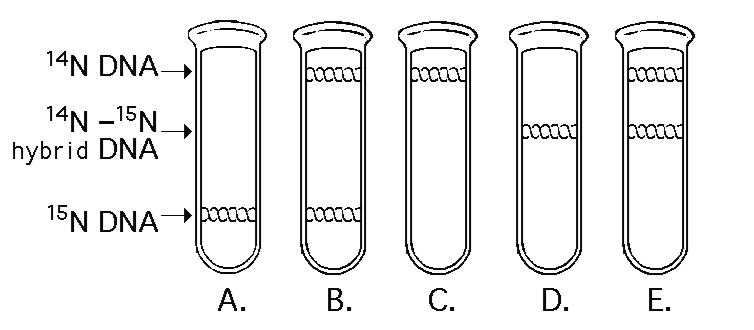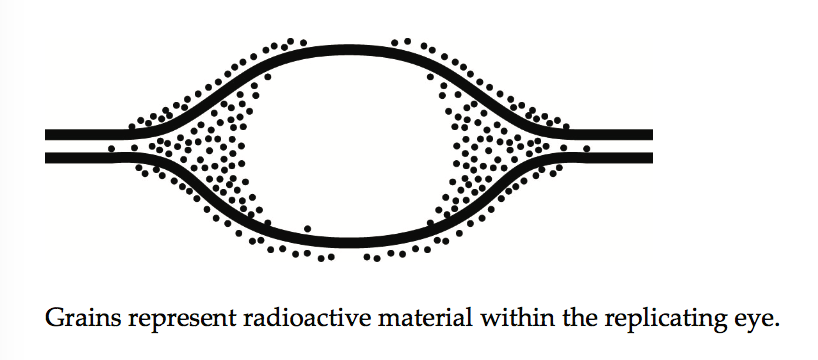In his transformation experiments, what did Griffith observe?
Mixing a heat-killed pathogenic strain of bacteria with a living nonpathogenic strain can convert some of the living cells into the pathogenic form.
How do we describe transformation in bacteria?
assimilation of external DNA into a cell
After mixing a heat-killed, phosphorescent strain of bacteria with a living nonphosphorescent strain, you discover that some of the living cells are now phosphorescent. Which observations would provide the best evidence that the ability to fluoresce is a heritable trait?
Descendants of the living cells are also phosphorescent.
In trying to determine whether DNA or protein is the genetic material, Hershey and Chase made use of which of the following facts?
DNA contains phosphorus, whereas protein does not.
Which of the following investigators was/were responsible for the following discovery? In DNA from any species, the amount of adenine equals the amount of thymine, and the amount of guanine equals the amount of cytosine.
Erwin Chargaff
Cytosine makes up 42% of the nucleotides in a sample of DNA from an organism. Approximately what percentage of the nucleotides in this sample will be thymine?
8%
Which of the following can be determined directly from X-ray diffraction photographs of crystallized DNA?
the diameter of the helix
It became apparent to Watson and Crick after completion of their model that the DNA molecule could carry a vast amount of hereditary information in which of the following?
sequence of bases
In an analysis of the nucleotide composition of DNA, which of the following will be found?
A + C = G + T
Replication in prokaryotes differs from replication in eukaryotes for which of the following reasons?
Prokaryotic chromosomes have a single origin of replication, whereas eukaryotic chromosomes have many.
What is meant by the description ʺantiparallelʺ regarding the strands that make up DNA?
The 5ʹ to 3ʹ direction of one strand runs counter to the 5ʹ to 3ʹ direction of the other strand.
Suppose you are provided with an actively dividing culture of E. coli bacteria to which radioactive thymine has been added. What would happen if a cell replicates once in the presence of this radioactive base?
DNA in both daughter cells would be radioactive.
An Okazaki fragment has which of the following arrangements?
5ʹ RNA nucleotides, DNA nucleotides 3ʹ
In E. coli, there is a mutation in a gene called dnaB that alters the helicase that normally acts at the origin. Which of the following would you expect as a result of this mutation?
No replication fork will be formed.
Which enzyme catalyzes the elongation of a DNA strand in the 5ʹ → 3ʹ direction?
DNA polymerase III
Eukaryotic telomeres replicate differently than the rest of the chromosome. This is a consequence of which of the following?
gaps left at the 5ʹ end of the lagging strand
The enzyme telomerase solves the problem of replication at the ends of linear chromosomes by which method?
adding numerous short DNA sequences such as TTAGGG, which form a hairpin turn
The DNA of telomeres has been found to be highly conserved throughout the evolution of eukaryotes. What does this most probably reflect?
that the critical function of telomeres must be maintained
At a specific area of a chromosome, the sequence of nucleotides below
is present where the chain opens to form a replication fork:
3ʹ
C C T A G G C T G C A A T C C 5ʹ
An RNA primer is formed
starting at the underlined T (T) of the template. Which of the
following represents the primer sequence?
5ʹ A C G U U A G G 3ʹ
Polytene chromosomes of Drosophila salivary glands each consist of multiple identical DNA strands that are aligned in parallel arrays. How could these arise?
replication without separation
To repair a thymine dimer by nucleotide excision repair, in which order do the necessary enzymes act?
endonuclease, DNA polymerase I, DNA ligase
What is the function of DNA polymerase III?
to add nucleotides to the 3ʹ end of a growing DNA strand
The difference between ATP and the nucleoside triphosphates used during DNA synthesis is that
the nucleoside triphosphates have the sugar deoxyribose; ATP has the sugar ribose.
The leading and the lagging strands differ in that
the leading strand is synthesized in the same direction as the movement of the replication fork, and the lagging strand is synthesized in the opposite direction.
A new DNA strand elongates only in the 5ʹ to 3ʹ direction because
DNA polymerase can only add nucleotides to the free 3ʹ end.
What is the function of topoisomerase?
relieving strain in the DNA ahead of the replication fork
What is the role of DNA ligase in the elongation of the lagging strand during DNA replication?
It joins Okazaki fragments together.
Which of the following help(s) to hold the DNA strands apart while they are being replicated?
single-strand binding proteins
Individuals with the disorder xeroderma pigmentosum are hypersensitive to sunlight. This occurs because their cells are impaired in what way?
They cannot repair thymine dimers.
Which of the following would you expect of a eukaryote lacking telomerase?
a reduction in chromosome length in gametes
- helicase
- DNA polymerase III
- ligase
- DNA polymerase I
- primase
Which of the enzymes removes the RNA nucleotides from the primer and adds equivalent DNA nucleotides to the 3ʹ end of Okazaki fragments?
IV
- helicase
- DNA polymerase III
- ligase
- DNA polymerase I
- primase
Which of the enzymes separates the DNA strands during replication?
I
- helicase
- DNA polymerase III
- ligase
- DNA polymerase I
- primase
Which of the enzymes covalently connects segments of DNA?
III
- helicase
- DNA polymerase III
- ligase
- DNA polymerase I
- primase
Which of the enzymes synthesizes short segments of RNA?
V
Which of the following sets of materials are required by both eukaryotes and prokaryotes for replication?
double-stranded DNA, four kinds of dNTPs, primers, origins
Studies of nucleosomes have shown that histones (except H1) exist in each nucleosome as two kinds of tetramers: one of 2 H2A molecules and 2 H2B molecules, and the other as 2 H3 and 2 H4 molecules. Which of the following is supported by this data?
The two types of tetramers associate to form an octamer.
In a linear eukaryotic chromatin sample, which of the following strands is looped into domains by scaffolding?
the 30-nm chromatin fiber
Which of the following statements describes the eukaryotic chromosome?
It consists of a single linear molecule of double-stranded DNA plus proteins.
If a cell were unable to produce histone proteins, which of the following would be a likely effect?
The cellʹs DNA couldnʹt be packed into its nucleus.
Which of the following statements is true of histones?
Histone H1 is not present in the nucleosome bead; instead, it draws the nucleosomes together.
Why do histones bind tightly to DNA?
Histones are positively charged, and DNA is negatively charged.
Which of the following represents the order of increasingly higher levels of organization of chromatin?
nucleosome, 30-nm chromatin fiber, looped domain
Which of the following statements describes chromatin?
Heterochromatin is highly condensed, whereas euchromatin is less compact.

In the late 1950s, Meselson and Stahl grew bacteria in a medium containing ʺheavyʺ nitrogen (15N) and then transferred them to a medium containing 14N. Which of the results in the figure above would be expected after one round of DNA replication in the presence of 14N?
D

A space probe returns with a culture of a microorganism found on a distant planet. Analysis shows that it is a carbon-based life-form that has DNA. You grow the cells in 15N medium for several generations and then transfer them to 14N medium. Which pattern in the figure above would you expect if the DNA was replicated in a conservative manner?
B
Once the pattern found after one round of replication was observed, Meselson and Stahl could be confident of which of the following conclusions?
Replication is not conservative.

In an experiment, DNA is allowed to replicate in an environment with all necessary enzymes, dATP, dCTP, dGTP, and radioactively labeled dTTP (3H thymidine) for several minutes and then switched to nonradioactive medium. It is then viewed by electron microscopy and autoradiography. The figure above represents the results. Which of the following is the most likely interpretation?
There are two replication forks going in opposite directions.
For a science fair project, two students decided to repeat the Hershey and Chase experiment, with modifications. They decided to label the nitrogen of the DNA, rather than the phosphate. They reasoned that each nucleotide has only one phosphate and two to five nitrogens. Thus, labeling the nitrogens would provide a stronger signal than labeling the phosphates. Why wonʹt this experiment work?
Amino acids (and thus proteins) also have nitrogen atoms; thus, the radioactivity would not distinguish between DNA and proteins.
You briefly expose bacteria undergoing DNA replication to radioactively labeled nucleotides. When you centrifuge the DNA isolated from the bacteria, the DNA separates into two classes. One class of labeled DNA includes very large molecules (thousands or even millions of nucleotides long), and the other includes short stretches of DNA (several hundred to a few thousand nucleotides in length). These two classes of DNA probably represent...
leading strands and Okazaki fragments.
In his work with pneumonia-causing bacteria and mice, Griffith found that
some substance from pathogenic cells was transferred to nonpathogenic cells, making them pathogenic.
What is the basis for the difference in how the leading and lagging strands of DNA molecules are synthesized?
DNA polymerase can join new nucleotides only to the 3ʹ end of a growing strand.
In analyzing the number of different bases in a DNA sample, which result would be consistent with the base-pairing rules?
A + G = C + T
The elongation of the leading strand during DNA synthesis
depends on the action of DNA polymerase.
In a nucleosome, the DNA is wrapped around...
histones.
E. coli cells grown on 15N medium are transferred to 14N medium and allowed to grow for two more generations (two rounds of DNA replication). DNA extracted from these cells is centrifuged. What density distribution of DNA would you expect in this experiment?
one low-density and one intermediate-density band
A biochemist isolates, purifies, and combines in a test tube a variety of molecules needed for DNA replication. When she adds some DNA to the mixture, replication occurs, but each DNA molecule consists of a normal strand paired with numerous segments of DNA a few hundred nucleotides long. What has she probably left out of the mixture?
DNA ligase
The spontaneous loss of amino groups from adenine in DNA results in hypoxanthine, an uncommon base, opposite thymine. What combination of proteins could repair such damage?
nuclease, DNA polymerase, DNA ligase